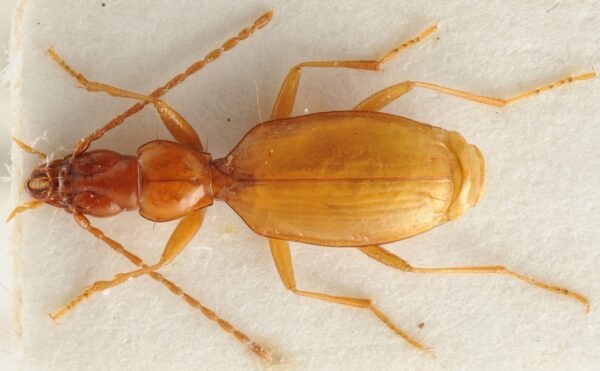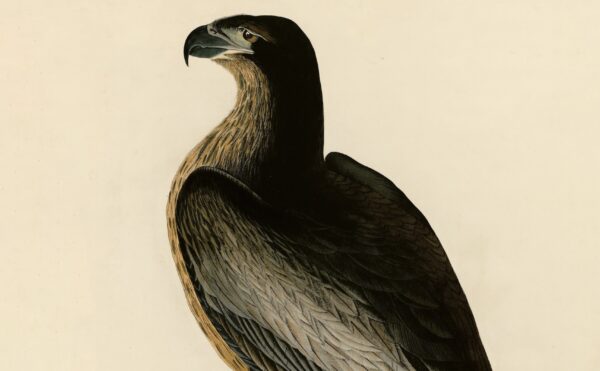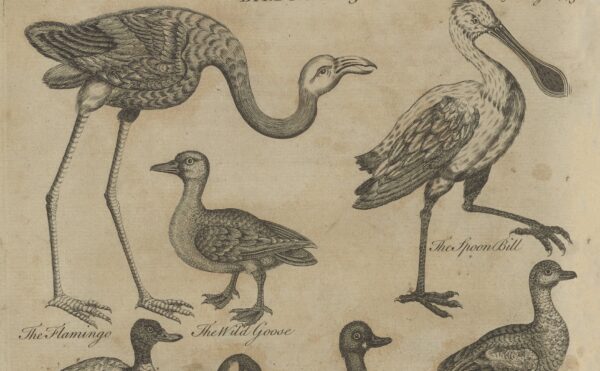The story of Douglas Prasher is a heartbreaking one. As a molecular biologist, he worked in genetics and biochemistry research and developed a Nobel Prize-worthy idea using green-fluorescent protein (GFP). But the tragedy that forced him to drop out of science and get shut out of winning the prestigious award was not from the script of a soap opera. Instead, it was something all too familiar that science hasn’t even begun to grapple with: how poverty affects the scientific labor market.
About The Disappearing Spoon
Hosted by New York Times best-selling author Sam Kean, The Disappearing Spoon tells little-known stories from our scientific past—from the shocking way the smallpox vaccine was transported around the world to why we don’t have a birth control pill for men. These topsy-turvy science tales, some of which have never made it into history books, are surprisingly powerful and insightful.
Credits
Host: Sam Kean
Senior Producer: Mariel Carr
Producer: Rigoberto Hernandez
Associate Producer: Sarah Kaplan
Audio Engineer: Rowhome Productions
Transcript
One morning in October 2008, Douglas Prasher nearly dropped his fork in shock at the breakfast table. He’d just heard some stunning news on the radio.
The 57-year-old Prasher listened to a lot of radio at work. He drove a shuttle van for a Toyota dealership in Huntsville, Alabama—although not by choice. He’d once been a molecular biologist.
Which is why that morning’s news shocked him. The radio said a few scientists had just won the Nobel Prize—using his ideas. In fact, he’d given them the DNA to start their research.
So how does a guy with a Nobel Prize–worthy idea end up driving a van for a living? Therein lies a sad story—about bad luck, bad timing, and the sad truth of what success requires in science.
Douglas Prasher looks like a bear—heavy, hairy, bearded. He was born to working-class parents in Ohio. After earning a Ph.D. in biology in 1979, he moved down to the University of Georgia.
There, he met a fellow scientist named Gina. The attraction was strong and mutual, but Prasher was shy. To get him out of his shell, Gina sent him a gorillagram—where someone shows up in a gorilla costume and sings at you. It was an ‘80s thing. The gorillagram embarrassed Prasher, but he and Gina did get married.
While in Georgia, Prasher began studying a sea creature, the crystal jellyfish. It lives in Puget Sound, near Seattle. What’s cool about crystal jellyfish is that they have a band of tissue that glows underwater. It just lights up like a firefly, except more blue-green.
In 1962, a Japanese biologist had isolated the two tiny proteins in crystal jellyfish that produced the blue-green light. One protein glowed blue when cells released calcium. Then, when the blue light glowed, the other protein absorbed that light and lit up green. Naturally, he named the second protein the green-fluorescing protein, or GFP.
While studying the jellyfish, Prasher got an idea. What if he took that tiny GFP, and stuck it onto another, bigger protein inside a cell? If you then shined blue light on that hybrid protein, it would glow green.
Now, that might sound like just a cheap trick. Why would you want a glowing protein? For medical research. At the time, scientists could not track proteins inside cells. It’s dark inside cells, and there are a bazillion other molecules churning around. Following one protein around was impossible in that mess.
And because scientists couldn’t follow proteins, they had only a murky idea of how our cells worked. More to the point, they didn’t know how to fix proteins when they malfunctioned—as proteins often do in diseases. This was a huge obstacle in medical research.
Suddenly, though, Prasher had a way to spotlight molecules. If he could attach GFP to proteins, scientists could see what those proteins did, how they moved, when and where they were active—all sorts of things. It would be a giant breakthrough.
In 1987, Prasher accepted a job to work on GFP at the Woods Hole Oceanographic Institute in Massachusetts. Prasher and his wife loved living by the seaside. They had a big garden full of asparagus and tomatoes. They fertilized everything with seaweed right from the ocean.
In 1988, Prasher got a $200,000 grant from the American Cancer Society. It thought that GFP could help doctors study cancer cells.
First thing first, Prasher had to find the DNA that makes GFP. This was not an easy job then. He traveled to Puget Sound in Washington, then used a pool skimmer to snag jellyfish out of the water one by one.
Then he sliced out the band of tissue that produces light, using a razor. The aftermath looked like a bucket of “translucent linguini,” he said. He then mixed the linguini with chemicals to extract the gooey DNA. Unfortunately, the organs that produce light are tiny—the size of poppy seeds. So tiny that to get enough DNA, Prasher had to collect 70,000 jellyfish—all by hand.
And this was before he even started sequencing DNA, an equally laborious job then—months of drudgery.
In the middle of all this, Prasher got a call from a biologist at Columbia University. Martin Chalfie had heard about GFP. And, independently, he’d also realized that you could use it to track proteins inside cells.
On the phone, Chalfie asked Prasher if he was was close to isolating the DNA for GFP. Prasher admitted no. Chalfie commiserated, and asked Prasher to keep in touch. He wanted to know the moment Prasher finished.
It took a full year. But in 1989, Prasher finally isolated the DNA and called Chalfie back—only to find that Chalfie was on sabbatical in Utah. The student who answered the phone promised to pass a message along. Then Prasher just went back to the lab. It wasn’t like he could text or email Chalfie. It was 1989.
Back in the lab, Prasher tried an experiment. He took the GFP DNA and inserted it into some bacteria. Then he shined blue light on the bacteria. He was hoping they’d glow green. Instead, nothing happened. The bacteria didn’t light up.
Prasher grumbled about this and tried again with other bacteria. They didn’t light up, either. He tried and tried again, but he couldn’t get microbes to glow. He had no idea why.
That wasn’t his only frustration. Although it’s a great institution, Woods Hole focuses on ocean research and marine biology. As a molecular biologist, Prasher felt isolated. No one there understood his research, or really cared. He wanted to work with people like Martin Chalfie at Columbia. But the guy never called him back.
Then, Prasher’s $200,000 grant ran dry. He applied for another grant from the National Institutes of Health. But NIH turned him down. Who cared about glow-in-the-dark jellyfish? What a waste of time.
With each month, Prasher grew more miserable. At one point, his three-year-old daughter sniffled, “Papa doesn’t smile anymore.” Eventually, he quit Woods Hole. It was an excruciating decision. But he couldn’t stand the isolation anymore. He took a job with the USDA instead, fighting agricultural pests.
Despite his setbacks, Prasher still believed in GFP—he still believed it could revolutionize medical research. So before leaving Woods Hole, he published a paper on what he’d learned.
A week later, Martin Chalfie at Columbia called. He was back from Utah. He’d seen the paper and was annoyed. Why hadn’t Prasher called?
Prasher bristled. He did call. Why didn’t Chalfie return his message?
Eventually, they realized that the grad student who took Prasher’s message had flaked out. He never passed it along. If the student had done so, Prasher’s career would have looked quite different. As it was, he told Chalfie he was quitting GFP research.
Chalfie was stunned. He begged Prasher to send him the DNA, so it wouldn’t be wasted. Prasher said sure, why not. He still believed in GFP.
Shortly afterward, Prasher got a second phone call. A biologist named Roger Tsien in San Diego also wanted some DNA from GFP. Again, Prasher said sure, have some.
A few days later, Prasher sealed some DNA inside two plastic test-tubes, and slid them into two padded envelopes. Then he drove to the post office. He later remembered feeling bummed out as he dropped the envelopes in the mail bin. It was the end of his GFP research—he was passing the torch to Chalfie and Tsien. He just hoped could do something useful with GFP.
After that, Prasher’s life unraveled. He liked his job fighting agricultural pests, but the USDA suddenly transferred him to Maryland. It happened during the school year, and this was hard on his family.
Feeling dissatisfied, he moved again in 2004, to work for a NASA contractor in Huntsville, Alabama. His job involved sensing toxic microbes in spaceships. He found the work exciting. It was NASA—cool stuff!
But eighteen months later, NASA slashed its budget. Prasher’s program got axed. Unwilling to move his family again, he tried finding work in Huntsville. But nothing turned up. Biologists simply weren’t in demand there.
A few years passed. When his savings dried up, Prasher finally accepted a job driving a shuttle van for a Toyota dealership.
He didn’t mind the job. But it wasn’t exactly intellectually stimulating. His coworkers were far more likely to talk about their latest fry-up of hog testicles than about genetics or GFP. Prasher once tried eating a kiwi at lunch there. A colleague stopped him, then scolded him about ingesting moldy potatoes.
Meanwhile, Prasher’s wish was coming true. GFP research was taking off. But as they say, be careful what you wish for.
After receiving the GFP DNA in the mail, Martin Chalfie at Columbia tried an experiment with a graduate student of his: Ghia Euskirchen. They wanted her to make GFP glow inside bacteria—the same experiment that failed for Prasher.
But Chalfie and Euskirchen made one important change. Prasher had removed the DNA from jellyfish with a sort of molecular scissors. Unfortunately, he used a scissors that didn’t cut precisely. He got the GFP DNA, but he got extra DNA, too—ragged bits hanging off the end.
As we now know, those ragged DNA threads doomed Prasher. When bacteria tried to make GFP, that extra DNA changed the molecule’s shape. This prevented it from glowing.
But Chalfie and Euskirchen used different molecular scissors. Their scissors cut more precisely. It removed only the GFP DNA, nothing more.
They slipped this clean DNA into the bacteria, and—pow! It lit right up. They put the DNA into a worm, too, and the worm lit up. This proved that GFP worked in other animals. You could make their proteins glow.
This was a gigantic deal. A picture of these glowing worms made the cover of Science magazine, one of the most prestigious journals in the world. It was a career-making event for Chalfie—and would have been for Prasher, too, if only the grad student had passed along the message in time for them to collaborate.
Meanwhile, Roger Tsien in San Diego was doing brilliant work of his own. He became the Picasso of glowing proteins. He tweaked GFP to make it glow red, cyan, and yellow.
He made these proteins shine brighter and longer, too. Now, thanks to the palette that Tsien made, instead of tracking one protein inside cells, scientists could track three or four at once.
Because of Chalfie and Tsien, interest in glowing proteins absolutely exploded. Millions of experiments around the world now use GFP and related molecules. They’re as common as microscopes in modern labs.
They’ve allowed scientists to do undreamed-of things. See brain development in babies; study how DNA turns off and on; track how tumors invade the body; and much more. It’s one of the most important tools ever in biology.
All of which led up to October 2008. The Nobel committee awarded that year’s prize in chemistry to Martin Chalfie and Roger Tsien, along with the Japanese scientist who’d first discovered GFP. Douglas Prasher got shut out.
Instead, Prasher first heard about the prize on the radio over breakfast. The news stirred a tumult of emotions inside him. One was pride. GFP was his idea—and it won a Nobel Prize! Imagine how smart you’d feel if your idea won a Nobel Prize.
At the same time, he felt crushing disappointment. And anger. He wasn’t mad at Chalfie or Tsien. He’d freely given them the DNA, and they’d done amazing work. He was mad at—life. At how it had gotten away from him. He was drowning in debt, working a crummy job.
In fact, after hearing the news that morning, he had to don his uniform and get to work, driving the van for 8½ bucks an hour. By the way, the Nobel winners that year split $1.4 million.
After the Nobel, Prasher gave a few media interviews about his fallen status and what could have been. He put on a brave face. He joked that Chalfie and Tsien owed him dinner. He also said he hated dressing up, and the black-tie Nobel ceremony would have been a huge pain. But he didn’t mean it.
To their credit, Tsien and Chalfie always stressed that they never could have succeeded without Prasher. After all, he discovered the GFP gene. Chalfie even said, hell, they could have included Prasher on the prize and left him out, and that would have been fair.
Generously, Tsien and Chalfie paid for Prasher and his wife to attend the Nobel ceremony in Stockholm. It was the couple’s first vacation in years. And despite his grousing, Prasher did rent a tuxedo to dress up.
For a night, he got to hobnob with the scientific elite—a taste of the life that might have been. Still, it was just a taste. It wasn’t him on stage accepting the prize. And when the ball ended, Cinderella returned to driving the shuttle van.
Later, Roger Tsien offered Prasher a job in San Diego. Prasher said no. It felt like a handout, a pity job. He also feared his lab skills were rusty.
But publicity from the Nobel did help him land a lab job in 2010. It was with another NASA contractor in Huntsville, to sense toxic gases in spaceships. The job lifted him out of his funk. His hangdog looked disappeared, and he started taking science journals to bed at night and falling asleep with his nose in them, just like old times.
In 2012, he even said yes to Tsien’s job offer, and joined his lab in San Diego. After leaving it behind that day in the post office, he got to finish his career on GFP.
But if Prasher’s story has a semi-happy ending, the tale still says bad things about science overall. A guy with a multibillion-dollar idea basically got pushed out of his field because the top U.S. funding agency refused to support him. After the Nobel, one biologist called Prasher’s life a “staggering waste of talent.”
His story also highlights the ridiculous things we make scientists do. Prasher had smarts, training, and a revolutionary idea. And he still failed, all because he didn’t play the bureaucratic game well. It’s ridiculous.
The Nobel Prize foundation deserves blame as well. They arbitrarily limit the prize to three people. It’s a stupid rule; they need to change it. Way back when, scientists mostly worked alone, but science nowadays is collaborative. There was no reason to deny Prasher.
And he’s far from alone. As you’ve maybe heard, this is Nobel Prize week. So by all means, praise the winners. For once each year, scientists get as much attention as actors and musicians.
But don’t forget the near-misses. The technicians. The grad students. The diffident ones like Prasher who got pushed out—or were a few unlucky breaks away from Nobel Prizes of their own.




